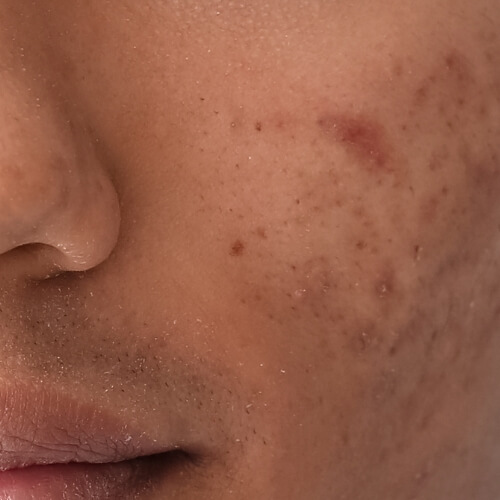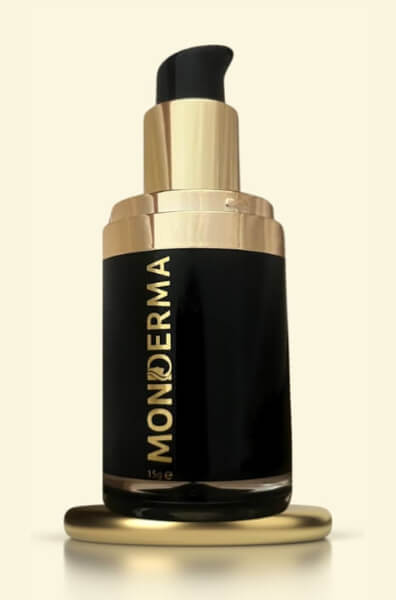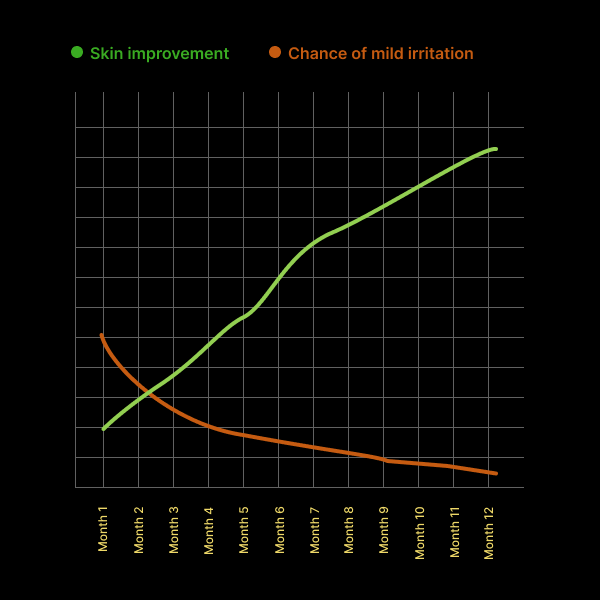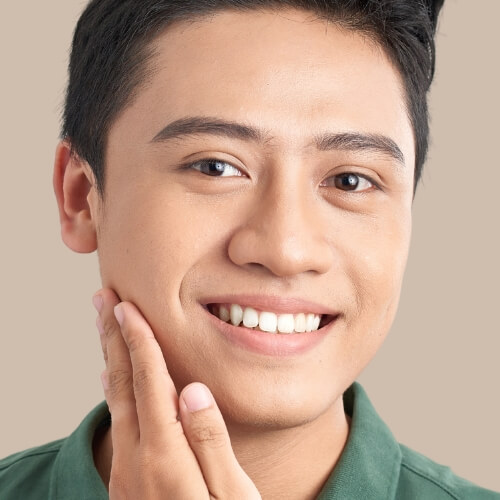
Battling Stubborn Breakouts?
Acne affects 95% of people in the UK, most commonly between the ages of 11 and 30, and can cause permanent skin damage.
But you do not have to live with it anymore. Erase spots, calm inflammation, and prevent pitting once and for all with Monderma’s new generation of ingredients.
Submit
Complete a short, free skin assessment
Start
Get your custom formula every 4 weeks
Support
Track progress, and cancel, restart anytime
What Is In Your Nightly Cream?
You will find 2-3 gold standard active ingredients, excipients, and a hyaluronic acid base cream sourced from MHRA suppliers in your acne removal formula.
Recyclable
Vegan Friendly
Cruelty Free
FRAGRANCE FREE
Alcohol Free
GPhC Regulated
MHRA Approved Suppliers
Dermatologist Tested
Pharmacist Led

The Monderma Difference
| Retail |  |
|---|---|
| Multiple products | All-in-one multitasker |
| Batch produced | Personalised |
| Over-the-counter | Pharmacist-led |
| Cosmetic ingredients | Active ingredients |
| Low strength | High strength |
| Rarely regulated | GPhC-regulated |
| Elementary checks | MHRA-suppliers |
| Typically imported | UK-compounded |
Transform Your Skin Today
Custom formulas are provided under the supervision of GPhC registered prescribers and pharmacists for safe, effective use.
As your treatment progresses, you will notice fewer spots and inflammation. Mild side effects such as peeling, tingling, and redness may occur but typically ease as your skin adjusts.

Tried, Tested, Loved: Hear It Firsthand
Give it a go!
“I have sensitive skin and mid-20s hormonal acne, Monderma is the first thing I’ve used in years that has actually worked.”
– Abbie, G, London, UK
My skin is now clearer than it’s been in years
“My skin has improved dramatically – the spots that used to bother me are gone, and even my old acne scars have faded.”
– Margaret, F, West Midlands, UK

Reveal your clearest skin with personalised skincare up to 20x the strength of over-the-counter acne products.
Still Have Questions?
Acne is an acute and chronic inflammatory skin condition that affects 95% of people in the UK between the ages of 11 and 30.
It typically begins in adolescence and is most common in girls aged 14 to 17 and boys aged 16 to 19, and improves in the twenties. Only 3% of adults over the age of 35 continue to experience breakouts.
Acne affects people with all skin tones equally, though scarring is more visible on darker skin tones.
The symptoms of acne are oily skin, spots, and occasional discomfort or pain.
Almost everyone who suffers from acne has it on their face, as this area contains the highest concentration of sebaceous (oil) glands. The condition affects half of people on the neck, shoulders, and back, as well as 15% on the chest.
Acne is classified into 6 subtypes:
| Subtype | Description | Common Areas |
|---|---|---|
| Blackheads (open comedones) | Small, non-inflammatory black or yellow bumps | Forehead, nose, and chin |
| Whiteheads (closed comedones) | Small, non-inflammatory lighter bumps, firmer than blackheads, and do not empty when squeezed | Forehead, nose, and chin |
| Papules (raised bumps) | Medium, inflammatory red bumps that can be tender | Forehead, cheeks, and jawline |
| Pustules (pus-filled bumps) | Medium, inflammatory red bumps, but with a white tip in the centre, unlike papules | Forehead, cheeks, and jawline |
| Nodules (deep-seated lumps) | Large, hard, inflammatory red lumps that may cause pain | Cheeks and jawline |
| Cysts (cystic acne) | Large, deep, pus-filled, inflammatory lumps that look like boils | Cheeks and jawline |
An estimated 90% of people with acne develop blackheads, 80% experience whiteheads, 70% have papules, 70% develop pustules, 20% experience nodules, and 10% suffer from cysts.
It is not uncommon to experience multiple subtypes of acne at once.
Acne is primarily caused inside hair follicles by the clogging of excess substances.
The skin naturally produces sebum, through its sebaceous glands located within the hair follicles. This oil is important for keeping the skin lubricated and protected.
However, when the body produces too much sebum, it can mix with dead skin cells and other debris, forming a sticky plug that clogs the follicles.
Hair follicles clog with:
| Cause | Description |
|---|---|
| Dead Skin Cells | Dead skin cells, which are pushed up through the surface of the skin to make space for new cells, can become trapped in the hair follicles, particularly in the sebaceous glands |
| Sebum | Sebum, produced by the sebaceous glands in the skin, is an oily substance. While normal sebum levels help maintain the pH (potential hydrogen) of the skin, overproduction can lead to acne |
| Bacteria | Bacteria are naturally present on the skin and help maintain its barrier function. However, a large number of bacteria can infiltrate pores |
Several other factors can influence the development and severity of acne:
| Contributor | Description |
|---|---|
| Genetics | Genetics play a significant role in the likelihood of developing acne. If one parent had acne, their children are likely to experience it, and if both parents suffered from acne, their children are very likely to develop it |
| Hormones | Hormonal changes that occur during puberty, menstrual cycles, pregnancy, perimenopause, menopause, postmenopause, and stress can cause an excess of sebum production, resulting in clogged pores |
| Diet | Diet has not been conclusively linked to acne, but it is believed that refined carbohydrates and foods high in sugars can cause an increase in insulin growth factor (IGF-1). This, in turn, blocks oil-secreting glands on the face, preventing them from breathing and increasing the risk of clogged pores |
| Medications | Medications such as testosterone, corticosteroids, and other anabolic-androgenic steroids (AAS), lithium, isoniazid, ciclosporin, anti-epileptics like phenytoin, carbamazepine, valproate, lamotrigine, phenobarbital, and levetiracetam, as well as halogens and epithelial growth factor receptor (EGFR) inhibitors, can cause drug-induced acne |
| Smoking | Smoking cigarettes can cause smoker's acne by reducing vitamin E production and altering sebum composition and density. This reduction in antioxidant activity clogs pores. Vaping can also dehydrate the skin, resulting in excess sebum production and clogged pores |
| Climate | Climate such as hot temperatures and humidity, particularly when wearing tight clothing, can alter the skin's pH balance, increasing sebum levels and sweat production, which clogs pores. Conversely, cold, dry weather can cause an increased sebum production, resulting in clogged pores and winter acne |
Most skincare products in the UK are non-comedogenic (water-based) and do not cause acne.
A doctor, pharmacist, or nurse can diagnose acne by visually examining the skin in-person, on video, or by images. This typically focuses on the face, neck, shoulders, back, and chest, where acne is most common. During this examination, the type and number of lesions are identified.
The health professional will ask about the patient’s symptoms and medical history to determine the duration and severity of the acne. Unlike other conditions, there is no specific test for acne.
Acne severity varies from mild to severe:
| Severity | Lesions | Description |
|---|---|---|
| Mild | Fewer than 30 lesions | Mostly blackheads and whiteheads, with a few papules and pustules |
| Moderate | Between 30-125 lesions | A higher count of blackheads and whiteheads, as well as more papules and pustules |
| Severe | Over 125 lesions | A large count of papules, pustules, nodules, or cysts |
One-third of people develop moderate to severe acne.
Acne's differential diagnosis includes several other skin conditions that can present with similar symptoms but have different underlying causes and treatments. These conditions include the following:
| Condition | Description |
|---|---|
| Dermatitis | Contact Dermatitis is a skin irritation caused by an allergic reaction to products or substances, resulting in red, itchy bumps that resemble acne. Perioral Dermatitis manifests as a rash-like condition around the mouth, nose, or eyes, resembling small red bumps and frequently misdiagnosed as acne |
| Folliculitis | Folliculitis is a hair follicle infection, typically from shaving, that causes red, pus-filled bumps, which resemble acne |
| Hidradenitis Suppurativa | Hidradenitis Suppurativa causes painful, inflamed lumps in the armpits, groin, or under the breasts, which resemble severe acne but frequently lead to abscesses |
| Kerastosis Pilaris | Keratosis Pilaris appears as small, rough bumps on the arms, thighs, and cheeks caused by keratin buildup in hair follicles, which resembles acne |
| Milia | Milia are small, white, cyst-like bumps caused by trapped keratin under the skin, often confused with whiteheads but without the inflammation seen in acne |
| Rosacea | Rosacea causes increased blood flow and inflammation in the skin, resulting in redness, acne-like lesions, visible blood vessels, and thickening, primarily on the face |
| Sebaceous Hyperplasia | Sebaceous Hyperplasia causes small yellowish bumps on the skin caused by enlarged sebaceous glands, which are similar to acne lesions but do not cause inflammation |
Other conditions even use the term acne in their nomenclature.
If the skin has not responded to over-the-counter products or is at risk of complications, Monderma may recommend a treatment plan.
This may contain up to 3 of the following ingredients:
| Topical | Properties |
|---|---|
| Retinoids | Regulate the growth of cells on the skin to improve its texture and tone |
| Anti-inflammatories | Inhibit the production of inflammatory-causing molecules on the skin to reduce redness and irritation |
| Antibiotics | Fight bacteria on the skin to reduce bumps and swelling |
| Antibacterials | Reduce the number of bacteria on the skin, preventing them from developing resistance, unlike antibiotics |
| Antioxidants | Eliminate free radicals by repairing and strengthening the barrier function of the skin, improving hydration |
Treating acne topically must include adopting daily use of broad-spectrum sunscreen of SPF30 or higher.
It can take 8 weeks or longer to see lasting results, so it is important to be patient and follow your treatment plan. Information on these ingredients, their directions for use, safety information, storage, potential side effects, and reporting can be found in the information leafletAcne can be stubborn, and difficult to treat. However, the earlier it is treated, the lower the risk of complications.
The common complications of acne include:
| Complication | Description |
|---|---|
| Atrophic Scars | Atrophic scars are the most common type of acne scar. Acne wounds that do not heal properly produce insufficient connective tissue, causing the scar to form beneath the surrounding tissue, which results in a dent in the skin. There are three subtypes of atrophic scars: ice pick scars, rolling scars, and boxcar scars. Ice pick scars are narrow, deep holes; rolling scars are shallow and uneven on the surface of the skin; and boxcar scars are large, oval depressions that are the most visible |
| Hypertrophic Scars | Hypertrophic scars are a less common type of acne scar. These raised scars can develop on the shoulders, back, or chest, particularly in people with severe acne. They form when the healing process produces an excessive amount of connective tissue. Itching and inflammation are possible side effects of hypertrophic scars |
| Keloid Scars | Keloid scars are a rare type of acne scar. They form when there is an excess of connective tissue, and unlike hypertrophic scars, they grow larger than the original inflamed area |
| Infection | Infection in acne lesions can lead to increased inflammation, resulting in more severe redness, swelling, and pain. It can lead to the formation of an abscess, which is characterised by painful, pus-filled lumps beneath the skin. Furthermore, chronic infections can exacerbate scarring, potentially resulting in both atrophic and hypertrophic scars. In rare cases, the infection can spread to the surrounding skin, causing cellulitis, or to other parts of the body |
| Sensitivity | Sensitivity from both topical and oral treatments can lead to increased skin issues. Topical treatments may result in dryness, redness, and irritation, while oral medications can cause heightened sensitivity or changes in skin condition. Managing these effects often requires adjusting the treatment or implementing protective measures |
| Hyperpigmentation | Hyperpigmentation occurs when inflammation from acne triggers excess melanin production, leading to dark spots and patches. This discoloration can persist long after the acne has healed, particularly in people with darker skin tones |
| Rosacea | Rosacea may develop in some people with a history of acne, which is characterised by facial redness, visible blood vessels, and acne-like breakouts |
| Psychosocial | Psychosocial effects of acne can include feelings of self-consciousness, anxiety, and stress. These emotional challenges can lead to reduced productivity at school or work, as well as a lower quality of life. If you or your child are experiencing depression or social isolation as a result of acne, seek help and advice from your doctor, chemist, or nurse |
Acne requires early and appropriate management, as well as ongoing assessment of treatment safety and tolerance.




